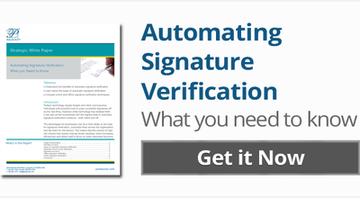A thoroughly engaged group of AIIM professionals swapped stories and asked questions and in a quick half hour roundtable with Parascript’s Chris Hill. “3 Ways to Use the Signatures You’re Scanning” was the topic that kicked off the discussion on day three of the 2014 AIIM Conference.
Signatures are a symbol of trust. They serve as a form of identification and are used for a range of liabilities from basic point of sale transactions to high value contracts. With so much at stake over personalized handwriting that is often illegible to even the writer, what is the value of automating signature recognition?
Let’s first consider the applications for signatures.
- Contracts: B2B and B2C, this is possibly the most abundant and critical signature application with substantial agreements affirmed by someone’s signature. Mortgages, collateral leases, master services agreements, and many other documents are being processed in high volumes by some firms, making automation a critical part fraud prevention and new application processing.
- Health Care: This spurred some debate in the AIIM session with many people recalling their latest experience at the pharmacy being totally paperless. This is true, with the exception of schedule II pharmaceuticals that still require a paper prescription. There is still substantial paperwork in healthcare for new customer applications, such as the forms required upon admission to the hospital or at the doctor’s office. Despite the requirements for electronic medical records, many incoming patient (customer) forms are handwritten and validated with a signature.
- Checks: No good check fraud discussion is complete without some story telling of the legend (and facts) of Frank Abagnale. By this standard, the discussion at AIIM was complete and we discussed the continuing financial implications and use cases for automatic signature verification of checks. If you are interested in the specifics of signature recognition, this blog post and white paper goes into the specifics to help you understand how you can benefit from Parascript’s signature verification solution. Checks continue to be a contributor to high volume signature processing.
The value of signature verification will vary by application but automation in the signature review process has a financial and productivity benefit. The 2013 Federal Reserve Payments Survey analyzed 2012 transactions and identified checks as the fraudulent transaction with the highest average ($1221 / fraudulent check). The potential for savings is the obvious benefit. The productivity benefit in automating signature capture and verification comes from reduced manual handling and acceleration of processing customer forms, especially new customers. One of signature verifications important roles is to identify and flag questionable signatures and utilize manual review for a subset of the forms, documents, contracts, or checks that are being processed.
We want to thank everyone that joined our roundtable discussion at AIIM 2014 and contributed to the discussion. Parascript’s Signature Verification Solutions and our team of capture experts are helping customers identify and implement applications to achieve their productivity and fraud prevention goals.
Learn more:




